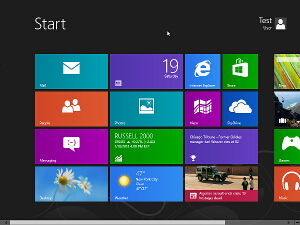Thoughts on Windows 8
Published by John on March 7, 2013 Under Computer Repair While at the CompUSA in Raleigh the other night, I made my way down the isle where they stock their pre-built computers and paused for a moment to listen to a salesman try his best to pitch the merits of Windows 8 to a couple. “See you just move your mouse to this side of the screen and a menu opens up.” he said, as the couple, looking slightly perplexed, gave him their undivided attention, nodding occasionally.
While at the CompUSA in Raleigh the other night, I made my way down the isle where they stock their pre-built computers and paused for a moment to listen to a salesman try his best to pitch the merits of Windows 8 to a couple. “See you just move your mouse to this side of the screen and a menu opens up.” he said, as the couple, looking slightly perplexed, gave him their undivided attention, nodding occasionally.
I couldn’t help but wonder what effect Windows 8 had had on his commission, as the numbers Microsoft has publicly released are pretty solid, but have been called into question by several third-party research firms. In any-case, I decided it was time to put my thoughts on Windows 8 out there.
A Bit of Background
I have used every version of Windows dating back to Windows 3.0 and 3.1 and before that MS DOS and the Apple II/III. So, I think it is probably fair to say that I have a good overview of how their Operating System has evolved over the years. In regards to Windows 8 specifically, I tried it during beta and spent a good bit of time working with it when I wrote my guide to getting started with Windows 8 a few months ago.
Thoughts on Metro: Its not all bad!
Ultimately, I have mixed feelings on Windows 8, specifically the Metro Desktop Environment. For a phone or tablet, or even possibly just for a very light user, it actually works pretty well. However, for a laptop/desktop OS and certainly someone trying to get real work done, it would not be my choice.
For example, once you figure out how the settings are laid out, the settings/file search is actually pretty cool. I think it ends up being pretty useful, although to be fair, without the setting search, I imagine trying to find where different settings live would be quite maddening.
I also think that for a user that mostly just wants to surf the web and maybe do some light computing, using Windows 8 is probably pretty easy to pickup. Despite being such a radical departure from the traditional desktop people are used to, I think the basics of it are easy to understand. For instance, my friend bought his older mother, who has never been that computer savvy, a Windows 8 laptop and she has enjoyed it so far. She really just uses it for browsing the Internet and has picked it up quite easily.
I don’t think using Windows 8 is not painful, although figuring out the mouse gestures and such takes some learning. It has some similarities to Gnome 3 and Unity desktop environments, which also received their fair share of user-complaints, but similarly have a number of redeeming and innovative qualities.
What I dislike About the New Operating System
Having said that, there are also some things I don’t like about Windows 8 and from a user-perspective I can certainly understand why so many people are less than excited about the prospect of having to learn the Windows 8 Metro style.
One of the main things that I dislike about Windows 8 is that I think Microsoft, likely looking at their decreasing market share to iPad and Android, took something that worked great and replaced it with something their customers probably didn’t really want.
Windows 7 refined Vista enough so that it ended up as a really solid operating system and people appreciated them for it, especially those that had bought a low-end Vista machine. However, these people, the ones that don’t have or want a tablet, like an iPad or Android, or simply like having a full keyboard, are, in my opinion, largely ignored and not well served by Microsoft’s decision to go Metro.
Of course, while under the hood Windows 7 is quite similar to Windows 8, the user-interface is what people notice and Windows Metro is a major change to what people have gotten accustomed to for the past 10+ years of their Windows experience. It remains to be seen whether this ends up revolutionizing the desktop or they follow in the steps of Vista, releasing the next version with a number of improvements. I would be surprised, however if the start menu didn’t re-appear in some shape or form in a future service pack or version. There are already third-party software that help fix the start menu.
There are also a lot of times as I was bounced from Metro to classic desktop and back again, that the Metro style felt like it was half-baked and kind of tacked on without a lot of thought. As a result, neither side of things, the ‘classic desktop’ mode or the Metro style really feels complete. Along these lines, while the setting search is neat, the settings themselves don’t feel well laid out, are in weird places, difficult to find, unintuitive, or apparently only found in the classic desktop control panel. There are also a lot of standard tasks, such as closing programs or shutting down the computer, which are different and unintuitive enough that many folks will likely end up needing to lookup or be shown how they work.
I think part of their long-term goal is to remain competitive with Android and Apple tablets, while differentiating Windows by offering a solution that allows people to switch between a full-desktop and mobile device. That is to say, offer a solution that lets you carry around your desktop computer in your pocket. Sort of like the new Ubuntu Mobile OS, which lets you dock your phone to get a full-operating system experience. This is quite an exciting concept, with there being no end to where you could take it. For example, a world where you can plug your phone into the headrest of your airplane to use a full-sized display and keyboard, would be quite awesome and probably not that far off.
However, as it stands, I think there is a long way to go and am quite interested to see where they head with Windows 9.
No Comments |

Add a Comment